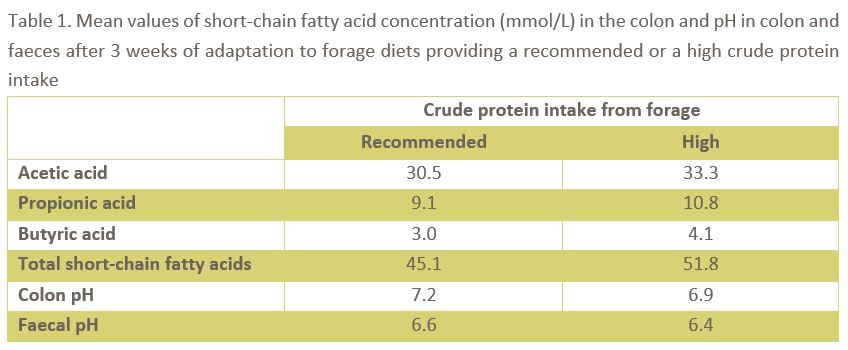Forage crude protein content and the hindgut ecosystem

Early harvested forage has high energy content but often also high crude protein content, which can result in an excessive crude protein intake. This study examined the impact on the colon and faecal ecosystem in maintenance fed horses when feeding two silage diets; one silage high in crude protein content (17 % = 128 g digestible cp/kg DM) that gave an excess protein intake and another silage (13 % = 91 g digestible cp/kg DM) that provided a recommended intake of crude protein.
There was no difference in the colon bacterial flora or the colon content and faecal dry matter (DM) concentration after 3 weeks of adaptation to the high crude protein silage and the silage providing the recommended crude protein intake. The concentration of short-chain fatty acids in the colon was higher when the horses were fed the high protein silage compared to the recommended (Table 1). The pH value of the colon content was also slightly lower on the high protein diet which can be due to the higher concentration of short-chain fatty acids. In comparison to other studies when starch rich concentrates have been introduced the pH value was still high on both silage diets.
The two diets did not result in any difference in the amounts of nitrogen, ammonia or urea in the colon fluid, which indicates that the absorption of the higher crude protein intake took place earlier in the gastrointestinal tract. The horses’ water intake and the plasma urea concentration tended to be higher when the horses were fed the high protein silage compared to the recommended. This also indicates that there was an increased absorption of nitrogen and a higher nitrogen metabolism on the high protein diet.
Abrupt feed changes between the silages were also performed and resulted in no or small changes in the colon ecosystem the first 24 hours. The concentration of total anaerobic bacteria and lactobacilli was a little higher 24 h after an abrupt change to the high protein silage. But there was no difference in colon and faecal pH or DM concentrations between the diets the first 24 h after the abrupt feed changes. Also the concentration of short-chain fatty acids and lactic acid in the colon did not differ between the diets the first 24 h.
The results show that an excess crude protein intake from forage, in horses fed at the maintenance level of energy intake, does not imply any major changes in the colon bacterial flora and its activity. In addition, an abrupt feed change between two forages with different crude protein content does not seem to be associated with the same risk of intestinal disorders as a change from forage to starch rich concentrate.
Sara Muhonen, AgrD
Proteins are composed of amino acids

